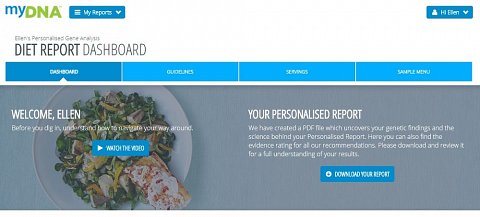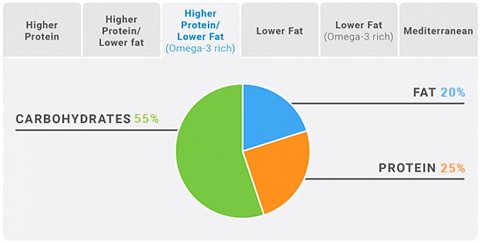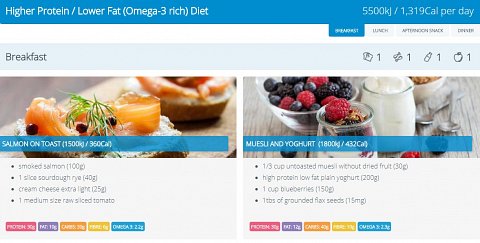-
Weight Management Test
review on 4 April 2018
by Ellen Hinkley

At a Glance
Summary
The myDNA Weight Management Test gave me a good look into important aspects of nutrition. I found the report easy to understand and enjoyed using the tools to plan my personalised diet. In particular, I found the meal planning and serving-size features helpful in putting quite abstract information into action.
In terms of the results themselves, I was pleased with the level of detail that was provided about the genes analysed and the scientific research that supported the findings. However, the advice was often a little vague and wasn’t as personal as I’d expected. I would therefore recommend the test to those interested in using their genetics as a base for developing a healthier diet, rather than those looking for advice based on specific results.
Full Review
myDNA was founded in 2007 by Les Sheffield, a geneticist whose career has seen him contribute to a range of pioneering genetics research. Most notably, Dr Sheffield was the first Australian to qualify as clinical geneticist, later overseeing the introduction a screening programme for Down’s Syndrome in pregnancy. More recently, he has focused his interest on pharmacogenomics and the role genes play in the metabolism.
After success in selling tests fitness, diet and medication tests in Australia, the company launched in the UK early this year, selling its ‘Weight Management Test’ exclusively via Lloyds Pharmacy. At £59, the test is a lot cheaper than similar alternatives, so we were intrigued to find out how it would compare!
Product Expectations
There was lots of information about the Weight Management Test on the myDNA website. It made it immediately clear that it was exclusively available via Lloyds Pharmacy and went on to explain the main features. A promotional video explained some of the benefits of the test and I read that it would decode the information in my genes to help me live better. This information would then be used to recommend the diet and serving sizes that would help me lose or maintain weight. I’d also be provided with menu plans to help me implement the advice.
A list of areas that would be reported on was also included, along with the name of the gene that would be analysed for each. This was just one example of the company’s emphasis on scientific evidence and credibility, which I was impressed to see.
There was a case study video that showed a woman called Sharon explaining her reasons for taking the test and what she’d gotten from it. Finally, a how it works section briefly described the three main steps involved in the testing process (“swab, register, send”), which seemed pretty straightforward.
Ordering Experience
I was pleased that I could order the test through Lloyds Pharmacy, as I was already familiar with and trusted this brand. The ‘Buy Now’ button on the myDNA website took me directly to the product page on the Lloyds Pharmacy website, where some further information was provided (e.g. that one of the genes analysed was the so-called ‘Obesity Gene’) and an image of the kit was shown.
Before proceeding with the purchase, I decided to check through the privacy policy and terms and conditions. I found it difficult to find either of these documents, but eventually came across a link to the privacy policy in an answer to a FAQ on the myDNA website.
This policy referred to My DNA Life Australia throughout, so I wasn’t quite sure that it was the right one, but I couldn’t find a UK-specific alternative. This policy didn’t contain anything that particularly concerned me, and I was pleased to read that they would never trade, sell or transfer my personal data to third parties, except to those that helped them to carry out the services I’d specifically requested. I was also impressed that they highlighted the potential risks involved when taking a genetic test, specifically in terms of life insurance. It also pointed out that this test didn’t report on any clinical variants, which reassured me that I wouldn’t receive any unwanted medical information.
Once I’d read through these policies, I added the test to my cart and clicked to checkout. This process could be completed by logging in to a Lloyds Pharmacy account or as a guest. I chose the second option and entered my delivery address, name, email and then my card details. I was happy to find that, as my order was over £35, home delivery (3-5 days) was free. There were also the options to upgrade to next day delivery for £5.99 or to ‘Click & Collect’ from a Lloyds Pharmacy store instead. I was pleased to see that I could add delivery notes, such as to leave the kit with a neighbour.
As it was, the kit was small enough to post through the letterbox. It arrived three days after I’d submitted my order, which had been confirmed in an email from Lloyds Pharmacy. The packaging was exactly the same as in the image I’d seen on the Lloyds Pharmacy website, though it was made of quite flimsy cardboard so I’m not sure I’d have been happy to give it as a gift. Inside, I found a swab, a sticker to add my personal details to and instructions on how to register my kit.
Registering and taking the sample were both simple and quick. The swab was already in a tube, which I put it back in after I’d taken it. I added my personal details (name, phone number, gender, date of sample and date of birth) to the sticker, then fixed it to the tube. The postage on the packaging was pre-paid, so I was able to pop it straight into the nearest post-box.
The Results
Four working days later I received an email, this time from myDNA, to confirm that my samples had arrived at the lab. This advised that my results would be ready in 10-15 working days, so I was thrilled when they arrived only four working days later!
This email informed me that my report was available via the account I’d set up when registering. There was also a tutorial video that took me through the features of the report, which I found really helpful.
Once I’d watched this video, I logged into my account and saw a welcome message above a link to my ‘Diet Report’. I clicked on this and was taken to a dashboard that I recognised from the tutorial video (shown below).

My Diet Report Dashboard.
From here, I was able to download the PDF report that contained my results and could also access my diet recommendations, serving-size advice and sample menus.
Results Section: PDF Report
The report opened to a bright but professional-looking title page. It showed some of my details, including my name, date of birth and the dates my DNA had been collected, analysed and reported on. It also included a ‘myDNA ID’ and ‘Pathology No.’. I wasn’t sure what these were and had only ever associated pathology with clinical issues.
This was followed by a comprehensive introduction to the report. It took up two pages and went over several aspects of the results, including the purpose, what was included and the limitations. It also covered some of the science behind the test, which I found particularly helpful.
After this, there was a “Genetic Summary” page, listed the results that were covered in the report. There were seven in total, ‘Weight and Appetite’, ‘Body Size and Weight Regain’, ‘Fat Storage’, ‘Fat Burning’, ‘Triglyceride Levels’, ‘Cholesterol and Triglyceride Levels’ and ‘Fatty Acid Processing’. Each was accompanied by the name of the gene analysed, a brief description and a coloured bullet point that gave me an idea of the outcome. Green results indicated a ‘Favourable’ result, orange a ‘Less Favourable’ and red a ‘Least Favourable’ one. I could see that fat burning and fatty acid processing would be areas to focus on, as these results were highlighted red.
Results Section: Diet Recommendations
Before going into these results in more detail, there was a page dedicated to my Diet Recommendations. These were shown on a pie chart, with three sections representing the proportions of carbohydrates, protein and fat I should be eating, according to my genetic results (shown below).

My Diet Recommendations.
As a bread and pasta addict, I was pleased to see that these recommended I eat a lot more carbohydrate than protein or fat. I was, therefore, surprised and a bit confused to see that this was labelled ‘Higher Protein/Lower Fat (Omega-3 rich)’, as there was no mention of omega-3, and it only recommended I eat 5% more protein than fat.
As previously mentioned, there were various tools to help me apply these recommendations to my everyday life, all of which could be accessed from my online account dashboard. Here, I found out that 55% of my calories should come from carbs, which equated to about 190g. I was also advised to eat 81g of protein and 30g of fat, making up the other 45% of my recommended calorie allowance.
These measurements were put into context on the ‘Serving Sizes’ tab, which provided the amounts of various foods I could eat to get the same number of calories (e.g. half a flatbread and two breakfast wheat biscuits would both provide around 115 calories). I could switch my goal from ‘Weight Loss’ to ‘Weight Maintenance’ at any point, which increased all the recommended serving sizes.
Finally, there was a ‘Sample Menu’, which suggested full meals for me to try, using these ingredients (shown below).

A part of my Sample Menu.
These provided with suggestions for breakfast, lunch, an afternoon snack and dinner. I found the suggestions particularly valuable in showing how the foods I’d seen on the Serving Sizes tab could be combined to make healthy, but tasty meals.
Results Section: Genetic Findings
Going back to the PDF report, I looked next at my detailed results, in a section titled ‘Genetic Findings’. These provided further information about the results I’d seen in my Genetic Summary, starting with ‘Weight, Appetite and Obesity’ (shown below).

My detailed Hunger, Appetite and Obesity result.
I was interested to see that I was part of the majority of the population that had a moderate chance of obesity. This made me feel better about the result, and I found it helpful that a percentage increase in risk had also been provided. However, there was a footnote that explained this only referred to a Caucasian population. I am Caucasian but didn’t remember disclosing this information to myDNA at any point and would have found this a bit frustrating had I not been.
The ‘Steps to Lose Weight’ didn’t seem that specific to my genetics, instead just giving general, sensible advice on how to stay in shape. However, looking through some of the other results, I found that there was more detailed and helpful advice. For example, in my ‘Triglyceride Levels’ result there were some specific suggestions for reducing the triglycerides in my blood, including increasing fibre intake. I wouldn’t have known this was an effective way to lower my triglyceride levels, so found this advice helpful.
For most of my results, I was in the majority. However, one of those that was highlighted red in the Genetic Summary showed that I was only part of 18% of the population that had a reduced ability to process fatty acids. I wasn’t sure what effects this might have, so appreciated the supporting information provided. This explained that my likelihood of having an imbalance of omega-3 and omega-6 levels was significant, and I had a higher chance of increased levels of triglycerides and low-density cholesterol (LDL-C) in my blood.
I had heard of cholesterol but wasn’t sure what low-density cholesterol differed from other types and wasn’t completely sure what triglycerides were either. Looking it up online, I found out on the that LDL cholesterol is the bad kind, and that triglycerides are a type of fat found in meats, dairy and cooking oils.
I was recommended to eat oily fish that contain lots of omega-3 and to consider taking an omega-3 supplement.
Results Section: Healthcare Professional Section
The final section of the report provided information designed for me to share with a healthcare professional. I was impressed that this provided plenty of details about the evidence that supported the findings of the report. As well as providing references to the research studies, this evidence had been rated using a detailed star system (shown below).

The star rating system used to assess the evidence.
I didn’t understand many of the criteria used in this system but, seeing as this section was clearly for healthcare professionals, I didn’t mind too much.
Each result received ratings for ‘Risk’ and ‘Diet’, which I found interesting and helpful in assessing how much to trust each finding. Overall, although this section wasn’t really designed for me to look at, I appreciated having access to this information and was glad it had been included.
Summary
The myDNA Weight Management Test gave me a good look into important aspects of nutrition. I found the report easy to understand and enjoyed using the tools to plan my personalised diet. In particular, I found the meal planning and serving-size features helpful in putting quite abstract information into action.
In terms of the results themselves, I was pleased with the level of detail that was provided about the genes analysed and the scientific research that supported the findings. However, the advice was often a little vague and wasn’t as personal as I’d expected. I would therefore recommend the test to those interested in using their genetics as a base for developing a healthier diet, rather than those looking for advice based on specific results.


